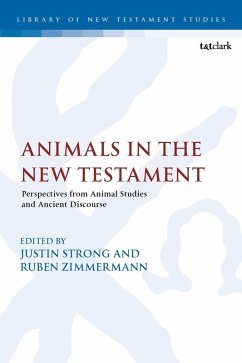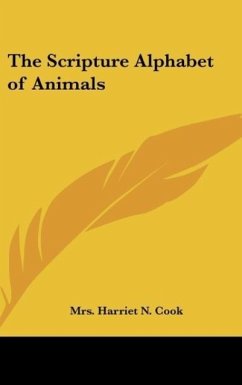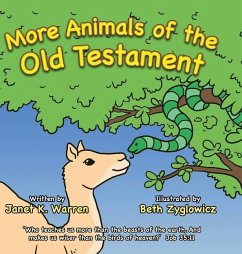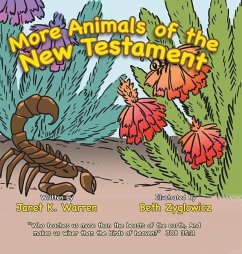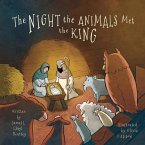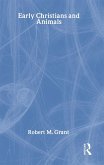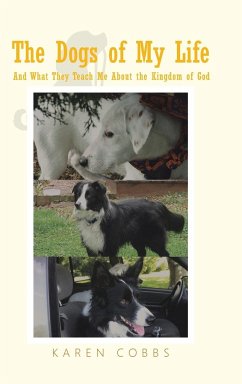Animals in the New Testament
Perspectives from Animal Studies and Ancient Contexts
Herausgeber: Strong, Justin David; Zimmermann, Ruben; Keith, Chris
Animals in the New Testament
Perspectives from Animal Studies and Ancient Contexts
Herausgeber: Strong, Justin David; Zimmermann, Ruben; Keith, Chris
- Gebundenes Buch
- Merkliste
- Auf die Merkliste
- Bewerten Bewerten
- Teilen
- Produkt teilen
- Produkterinnerung
- Produkterinnerung
This volume draws upon the diverse methods of Animal Studies and the ancient discourses around animals to shed light on the New Testament.
Andere Kunden interessierten sich auch für
![The Scripture Alphabet of Animals The Scripture Alphabet of Animals]() Harriet N. CookThe Scripture Alphabet of Animals33,99 €
Harriet N. CookThe Scripture Alphabet of Animals33,99 €![More Animals of the Old Testament More Animals of the Old Testament]() Janet K. WarrenMore Animals of the Old Testament34,99 €
Janet K. WarrenMore Animals of the Old Testament34,99 €![More Animals of the New Testament More Animals of the New Testament]() Janet K. WarrenMore Animals of the New Testament37,99 €
Janet K. WarrenMore Animals of the New Testament37,99 €![The Night the Animals Met the King The Night the Animals Met the King]() James BeatteyThe Night the Animals Met the King22,99 €
James BeatteyThe Night the Animals Met the King22,99 €![God and Horses God and Horses]() Nicole BortolussiGod and Horses14,99 €
Nicole BortolussiGod and Horses14,99 €![Early Christians and Animals Early Christians and Animals]() Robert M GrantEarly Christians and Animals197,99 €
Robert M GrantEarly Christians and Animals197,99 €![The Dogs of My Life The Dogs of My Life]() Karen CobbsThe Dogs of My Life25,99 €
Karen CobbsThe Dogs of My Life25,99 €-
-
-
This volume draws upon the diverse methods of Animal Studies and the ancient discourses around animals to shed light on the New Testament.
Hinweis: Dieser Artikel kann nur an eine deutsche Lieferadresse ausgeliefert werden.
Hinweis: Dieser Artikel kann nur an eine deutsche Lieferadresse ausgeliefert werden.
Produktdetails
- Produktdetails
- Verlag: Bloomsbury Academic
- Seitenzahl: 288
- Erscheinungstermin: 26. Juni 2025
- Englisch
- Abmessung: 234mm x 156mm x 25mm
- Gewicht: 454g
- ISBN-13: 9780567715821
- ISBN-10: 0567715825
- Artikelnr.: 71613428
- Herstellerkennzeichnung
- Libri GmbH
- Europaallee 1
- 36244 Bad Hersfeld
- gpsr@libri.de
- Verlag: Bloomsbury Academic
- Seitenzahl: 288
- Erscheinungstermin: 26. Juni 2025
- Englisch
- Abmessung: 234mm x 156mm x 25mm
- Gewicht: 454g
- ISBN-13: 9780567715821
- ISBN-10: 0567715825
- Artikelnr.: 71613428
- Herstellerkennzeichnung
- Libri GmbH
- Europaallee 1
- 36244 Bad Hersfeld
- gpsr@libri.de
Justin David Strong is Associate Professor of New Testament at MF Norwegian School of Theology, Religion and Society; Principal Investigator of "The Ancient Fable Tradition and Early Christian Literature" DFG Project at the Johannes Gutenberg University Mainz; and Research Associate at the New Testament and Related Literature Dept., University of Pretoria. Ruben Zimmermann is University Professor of New Testament on the Faculty of Protestant Theology at the Johannes Gutenberg University Mainz, Germany.
Preface
Acknowledgments
Abbreviations
Part I: Introduction
Chapter One: The Animal and the Beginning of the Gospel: An Orientation to
Animal Studies - Justin David Strong, MF Norwegian School of Theology,
Religion, and Society, Norway; University of Mainz, Germany
Part II: Classical Contexts
Chapter Two: Do Non-human Animals Have a Soul and Logos? Perspectives from
Pagan, Jewish, and Christian Thought - Hedwig Schmalzgruber, University of
Graz, Austria
Chapter Three: Animal Emotions in Greco-Roman 'Popular' Science and
Philosophy and in Imaginative Genres - Stephen Newmyer, Duquesne
University, USA
Chapter Four: On Focalization in Ancient Verse Fables and in the New
Testament: Animals in Contemporary Narrative Literature - Ursula Gärtner,
University of Graz, Austria
Part III: Gospels
Chapter Five: Humanimals, Godanimals, Demonimals: Is the Animetaphorical
Habitat of the New Testament Dangerous for Nonhuman Animals? - Stephen
Moore, Drew University Theological School, USA
Chapter Six: How Are the Children before the Dogs? Reading Jesus's
Encounter with the Syrophoenician Woman
within Ancient Child-Dog Symbolism - John Van Maaren, University of
Heidelberg, Germany
Chapter Seven: The Choice to Untie a Donkey, Ox or 'Daughter of Abraham' -
Emma Swai, Liverpool Hope University, UK
Chapter Eight: About Sheep and Their Keepers: Parallels in Literary Usage -
Ursula Ulrike Kaiser, University of Jena, Germany
Chapter Nine: "No Longer Do I Call You Slaves, Rather Friends:" Animal,
Slave, and Human Hierarchy in the Logic of John - Ruben Zimmermann,
University of Mainz, Germany
Part IV: Peter, Paul, and John
Chapter Ten: Eating and Seeing: The Birds and Animals and Creeping Things
of Acts 10:12 and Romans 1:23 - Sophia Niepert-Rumel, University of
Paderborn, Germany
Chapter Eleven: 'Is God Concerned with Oxen?' (1 Corinthians 9:9-10) -
Joel White, Free Theological University Giessen, Germany
Chapter Twelve: Of Men, Dogs, and 'Mutilated Monsters': Paul's Use of
Dehumanizing Terminology in Phil 3:2 and
Beyond - Gregory Lamb, Southeastern Baptist Theological Seminary, USA
Chapter Thirteen: Paganism's Champion: Interpreting the Diabolical Lion
Metaphor of 1 Peter 5.8 alongside Early Jewish Literature - Noel Cheong,
Oxford University, UK
Chapter Fourteen: Animals and the Eschaton: Outside are the Dogs... and the
Rest? - Michelle Fletcher, King's College London, UK
Part V: Extra-Canonical Christian Contexts
Chapter Fifteen: Jesus, Goats, and Other Animals in the Epistle of
Barnabas: The Intersection of Animal Symbolism and Implicit Ethics in the
Epistle of Barnabas - Travis W. Proctor, Wittenberg University, Germany
Chapter Sixteen: Animals' Sight of God? Justin Martyr on the Transmigration
of Souls (Dialogue with Trypho 4) - Jonathan H. Young, University of
Oxford, UK
Chapter Seventeen: A Venomous Snake of Toxic Speech and Other Animals
Illustrating Biblical Ethics in the Apocryphal Acts of the Apostles -
Susanna Luther, University of Göttingen, Germany
Chapter Eighteen: Between Antelopes and Hyenas: Animals in Egyptian Ascetic
and Monastic Texts - Ingvild Sælid Gilhus, University of Bergen, Norway
Bibliography
Index
Acknowledgments
Abbreviations
Part I: Introduction
Chapter One: The Animal and the Beginning of the Gospel: An Orientation to
Animal Studies - Justin David Strong, MF Norwegian School of Theology,
Religion, and Society, Norway; University of Mainz, Germany
Part II: Classical Contexts
Chapter Two: Do Non-human Animals Have a Soul and Logos? Perspectives from
Pagan, Jewish, and Christian Thought - Hedwig Schmalzgruber, University of
Graz, Austria
Chapter Three: Animal Emotions in Greco-Roman 'Popular' Science and
Philosophy and in Imaginative Genres - Stephen Newmyer, Duquesne
University, USA
Chapter Four: On Focalization in Ancient Verse Fables and in the New
Testament: Animals in Contemporary Narrative Literature - Ursula Gärtner,
University of Graz, Austria
Part III: Gospels
Chapter Five: Humanimals, Godanimals, Demonimals: Is the Animetaphorical
Habitat of the New Testament Dangerous for Nonhuman Animals? - Stephen
Moore, Drew University Theological School, USA
Chapter Six: How Are the Children before the Dogs? Reading Jesus's
Encounter with the Syrophoenician Woman
within Ancient Child-Dog Symbolism - John Van Maaren, University of
Heidelberg, Germany
Chapter Seven: The Choice to Untie a Donkey, Ox or 'Daughter of Abraham' -
Emma Swai, Liverpool Hope University, UK
Chapter Eight: About Sheep and Their Keepers: Parallels in Literary Usage -
Ursula Ulrike Kaiser, University of Jena, Germany
Chapter Nine: "No Longer Do I Call You Slaves, Rather Friends:" Animal,
Slave, and Human Hierarchy in the Logic of John - Ruben Zimmermann,
University of Mainz, Germany
Part IV: Peter, Paul, and John
Chapter Ten: Eating and Seeing: The Birds and Animals and Creeping Things
of Acts 10:12 and Romans 1:23 - Sophia Niepert-Rumel, University of
Paderborn, Germany
Chapter Eleven: 'Is God Concerned with Oxen?' (1 Corinthians 9:9-10) -
Joel White, Free Theological University Giessen, Germany
Chapter Twelve: Of Men, Dogs, and 'Mutilated Monsters': Paul's Use of
Dehumanizing Terminology in Phil 3:2 and
Beyond - Gregory Lamb, Southeastern Baptist Theological Seminary, USA
Chapter Thirteen: Paganism's Champion: Interpreting the Diabolical Lion
Metaphor of 1 Peter 5.8 alongside Early Jewish Literature - Noel Cheong,
Oxford University, UK
Chapter Fourteen: Animals and the Eschaton: Outside are the Dogs... and the
Rest? - Michelle Fletcher, King's College London, UK
Part V: Extra-Canonical Christian Contexts
Chapter Fifteen: Jesus, Goats, and Other Animals in the Epistle of
Barnabas: The Intersection of Animal Symbolism and Implicit Ethics in the
Epistle of Barnabas - Travis W. Proctor, Wittenberg University, Germany
Chapter Sixteen: Animals' Sight of God? Justin Martyr on the Transmigration
of Souls (Dialogue with Trypho 4) - Jonathan H. Young, University of
Oxford, UK
Chapter Seventeen: A Venomous Snake of Toxic Speech and Other Animals
Illustrating Biblical Ethics in the Apocryphal Acts of the Apostles -
Susanna Luther, University of Göttingen, Germany
Chapter Eighteen: Between Antelopes and Hyenas: Animals in Egyptian Ascetic
and Monastic Texts - Ingvild Sælid Gilhus, University of Bergen, Norway
Bibliography
Index
Preface
Acknowledgments
Abbreviations
Part I: Introduction
Chapter One: The Animal and the Beginning of the Gospel: An Orientation to
Animal Studies - Justin David Strong, MF Norwegian School of Theology,
Religion, and Society, Norway; University of Mainz, Germany
Part II: Classical Contexts
Chapter Two: Do Non-human Animals Have a Soul and Logos? Perspectives from
Pagan, Jewish, and Christian Thought - Hedwig Schmalzgruber, University of
Graz, Austria
Chapter Three: Animal Emotions in Greco-Roman 'Popular' Science and
Philosophy and in Imaginative Genres - Stephen Newmyer, Duquesne
University, USA
Chapter Four: On Focalization in Ancient Verse Fables and in the New
Testament: Animals in Contemporary Narrative Literature - Ursula Gärtner,
University of Graz, Austria
Part III: Gospels
Chapter Five: Humanimals, Godanimals, Demonimals: Is the Animetaphorical
Habitat of the New Testament Dangerous for Nonhuman Animals? - Stephen
Moore, Drew University Theological School, USA
Chapter Six: How Are the Children before the Dogs? Reading Jesus's
Encounter with the Syrophoenician Woman
within Ancient Child-Dog Symbolism - John Van Maaren, University of
Heidelberg, Germany
Chapter Seven: The Choice to Untie a Donkey, Ox or 'Daughter of Abraham' -
Emma Swai, Liverpool Hope University, UK
Chapter Eight: About Sheep and Their Keepers: Parallels in Literary Usage -
Ursula Ulrike Kaiser, University of Jena, Germany
Chapter Nine: "No Longer Do I Call You Slaves, Rather Friends:" Animal,
Slave, and Human Hierarchy in the Logic of John - Ruben Zimmermann,
University of Mainz, Germany
Part IV: Peter, Paul, and John
Chapter Ten: Eating and Seeing: The Birds and Animals and Creeping Things
of Acts 10:12 and Romans 1:23 - Sophia Niepert-Rumel, University of
Paderborn, Germany
Chapter Eleven: 'Is God Concerned with Oxen?' (1 Corinthians 9:9-10) -
Joel White, Free Theological University Giessen, Germany
Chapter Twelve: Of Men, Dogs, and 'Mutilated Monsters': Paul's Use of
Dehumanizing Terminology in Phil 3:2 and
Beyond - Gregory Lamb, Southeastern Baptist Theological Seminary, USA
Chapter Thirteen: Paganism's Champion: Interpreting the Diabolical Lion
Metaphor of 1 Peter 5.8 alongside Early Jewish Literature - Noel Cheong,
Oxford University, UK
Chapter Fourteen: Animals and the Eschaton: Outside are the Dogs... and the
Rest? - Michelle Fletcher, King's College London, UK
Part V: Extra-Canonical Christian Contexts
Chapter Fifteen: Jesus, Goats, and Other Animals in the Epistle of
Barnabas: The Intersection of Animal Symbolism and Implicit Ethics in the
Epistle of Barnabas - Travis W. Proctor, Wittenberg University, Germany
Chapter Sixteen: Animals' Sight of God? Justin Martyr on the Transmigration
of Souls (Dialogue with Trypho 4) - Jonathan H. Young, University of
Oxford, UK
Chapter Seventeen: A Venomous Snake of Toxic Speech and Other Animals
Illustrating Biblical Ethics in the Apocryphal Acts of the Apostles -
Susanna Luther, University of Göttingen, Germany
Chapter Eighteen: Between Antelopes and Hyenas: Animals in Egyptian Ascetic
and Monastic Texts - Ingvild Sælid Gilhus, University of Bergen, Norway
Bibliography
Index
Acknowledgments
Abbreviations
Part I: Introduction
Chapter One: The Animal and the Beginning of the Gospel: An Orientation to
Animal Studies - Justin David Strong, MF Norwegian School of Theology,
Religion, and Society, Norway; University of Mainz, Germany
Part II: Classical Contexts
Chapter Two: Do Non-human Animals Have a Soul and Logos? Perspectives from
Pagan, Jewish, and Christian Thought - Hedwig Schmalzgruber, University of
Graz, Austria
Chapter Three: Animal Emotions in Greco-Roman 'Popular' Science and
Philosophy and in Imaginative Genres - Stephen Newmyer, Duquesne
University, USA
Chapter Four: On Focalization in Ancient Verse Fables and in the New
Testament: Animals in Contemporary Narrative Literature - Ursula Gärtner,
University of Graz, Austria
Part III: Gospels
Chapter Five: Humanimals, Godanimals, Demonimals: Is the Animetaphorical
Habitat of the New Testament Dangerous for Nonhuman Animals? - Stephen
Moore, Drew University Theological School, USA
Chapter Six: How Are the Children before the Dogs? Reading Jesus's
Encounter with the Syrophoenician Woman
within Ancient Child-Dog Symbolism - John Van Maaren, University of
Heidelberg, Germany
Chapter Seven: The Choice to Untie a Donkey, Ox or 'Daughter of Abraham' -
Emma Swai, Liverpool Hope University, UK
Chapter Eight: About Sheep and Their Keepers: Parallels in Literary Usage -
Ursula Ulrike Kaiser, University of Jena, Germany
Chapter Nine: "No Longer Do I Call You Slaves, Rather Friends:" Animal,
Slave, and Human Hierarchy in the Logic of John - Ruben Zimmermann,
University of Mainz, Germany
Part IV: Peter, Paul, and John
Chapter Ten: Eating and Seeing: The Birds and Animals and Creeping Things
of Acts 10:12 and Romans 1:23 - Sophia Niepert-Rumel, University of
Paderborn, Germany
Chapter Eleven: 'Is God Concerned with Oxen?' (1 Corinthians 9:9-10) -
Joel White, Free Theological University Giessen, Germany
Chapter Twelve: Of Men, Dogs, and 'Mutilated Monsters': Paul's Use of
Dehumanizing Terminology in Phil 3:2 and
Beyond - Gregory Lamb, Southeastern Baptist Theological Seminary, USA
Chapter Thirteen: Paganism's Champion: Interpreting the Diabolical Lion
Metaphor of 1 Peter 5.8 alongside Early Jewish Literature - Noel Cheong,
Oxford University, UK
Chapter Fourteen: Animals and the Eschaton: Outside are the Dogs... and the
Rest? - Michelle Fletcher, King's College London, UK
Part V: Extra-Canonical Christian Contexts
Chapter Fifteen: Jesus, Goats, and Other Animals in the Epistle of
Barnabas: The Intersection of Animal Symbolism and Implicit Ethics in the
Epistle of Barnabas - Travis W. Proctor, Wittenberg University, Germany
Chapter Sixteen: Animals' Sight of God? Justin Martyr on the Transmigration
of Souls (Dialogue with Trypho 4) - Jonathan H. Young, University of
Oxford, UK
Chapter Seventeen: A Venomous Snake of Toxic Speech and Other Animals
Illustrating Biblical Ethics in the Apocryphal Acts of the Apostles -
Susanna Luther, University of Göttingen, Germany
Chapter Eighteen: Between Antelopes and Hyenas: Animals in Egyptian Ascetic
and Monastic Texts - Ingvild Sælid Gilhus, University of Bergen, Norway
Bibliography
Index

